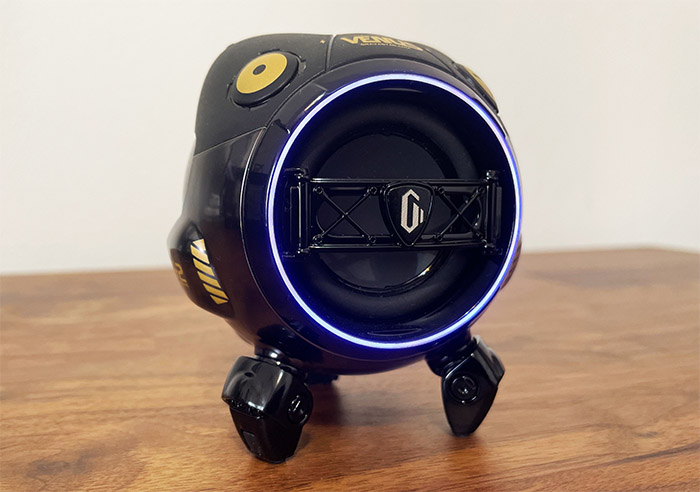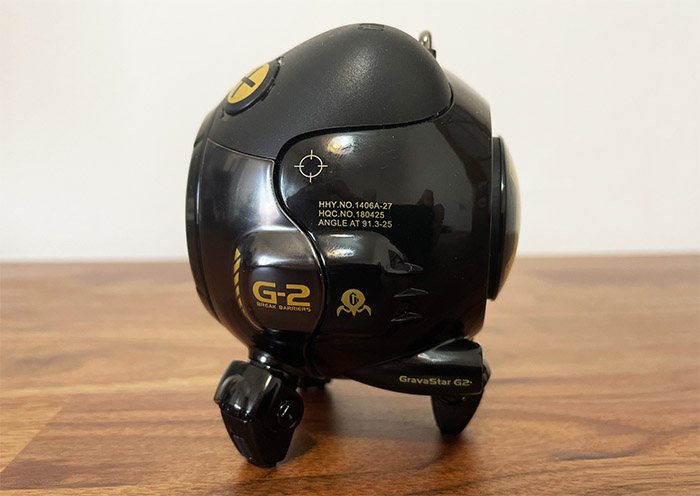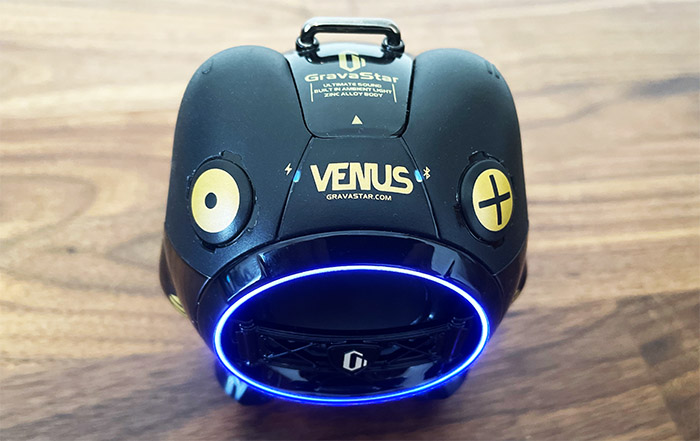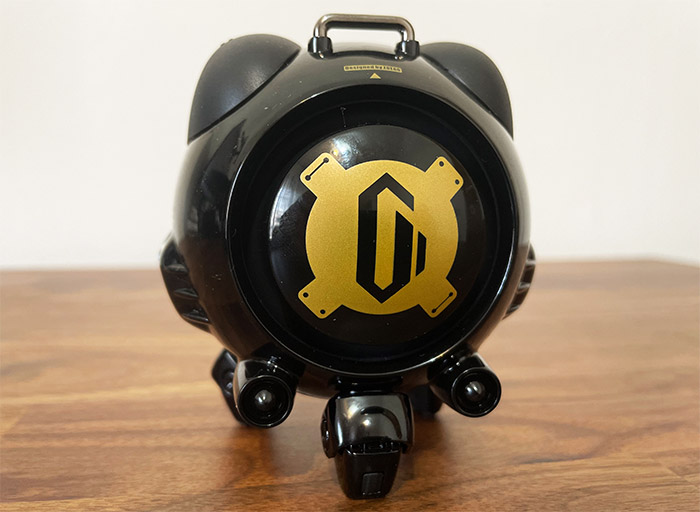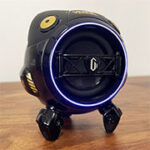The GravaStar Venus is the second generation of Bluetooth speakers developed by the manufacturer of audio devices and, while less flashy than the G1 (GravaStar Mars), it’s still following the cyberpunk genre style.
| GravaStar Venus | |
|---|---|
| GravaStar.com | Check Product |
Sure enough, the legs got shorter (the arachnid look is pretty much gone) and the entire device is smaller. And the light taming of the design was a wise decision since the idea is to cater to a wider audience and not just those that love the Sci-Fi cyberpunk genre. Don’t get me wrong, the device is still deeply Sci-Fi inspired, but I see it as a more appealing accessory for more people.
But is it just that, a sort of fashion statement? The GravaStar Mars (G1) was not only a well-built device, but it could also hold its ground against its competitors in terms of sound quality. Certainly not audiophile level, but that’s not the point of these types of Bluetooth speakers.
The idea is to be loud, fairly accurate and easy to carry. Which is why the GravaStar Venus is actually better than its predecessor, despite being smaller. I say that because it apparently is just as loud (if not louder than the G1), the sound doesn’t get distorted at higher volumes and the build quality seems to be excellent.
And that’s besides being completely unique in terms of design. So let’s put it to the test and see how well the GravaStar Venus fares, and whether you should consider taking it along on your outdoors adventures.
Build Quality and Design
I have recently tested the GravaStar Sirius TWS earbuds and the charging case was without a doubt the best designed I had seen until that point and the manufacturer made no compromises in terms of used materials. And pretty much the same can be told about the GravaStar Venus as well.
Most of the outer shell is made of zinc alloy, so the speaker does weigh a bit more than other devices in the same price range. But, at 1lbs, it gains that premium feel that most of us prefer when dealing with electronic devices. The GravaStar Mars was a bit larger than the Venus, occupying 7.1 x 7.9 inches which wasn’t really that much, but it would still require some planning if you intended to keep it on the desk.
But the GravaStar Venus measures far less and, at 2.8 x 2.4 x 3.2 inches, you can leave it pretty much anywhere in the room. Still, since it does have an integrated subwoofer, you should consider putting it next to a wall to get a better bass representation. Also, it’s best to keep it a bit higher, closer to your head level – it would have been great if those three small feet would have allowed some form of position adjustment.
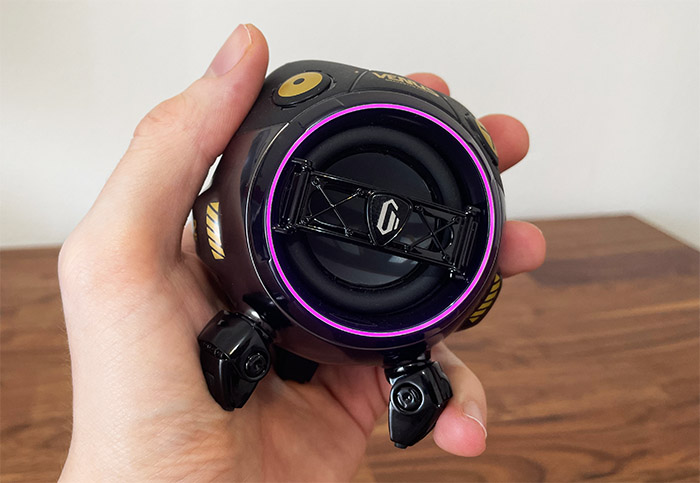
But they don’t, so put the speaker a bit higher than your desk. Speaking of feet, GravaStar did add some silicone pads to ensure that the speaker sits into place and next to them, there are two small propulsion systems to help the Venus take off.
It’s obviously just for design purposes and so do other parts of the case including the front where there’s a plastic narrow grill. And it’s clear that the Sci-Fi, cyberpunk elements are here (labels, icons and the shape of the case), just as they were on the Mars and Mars Pro, but the ominous look is gone.
Instead, the GravaStar Venus has actually gained a sort of cute look, mimicking something you would see in a Sci-Fi anime (the two ears are a clear give away). At the top of the case, there is a small metallic handle that you can use to hook up the speaker to your backpack, but is the device actually built to survive outdoor conditions?
It definitely feels solid and the zinc alloy should protect it from shocks up to a certain point, but I couldn’t find any clear indication on their website about the protection against water ingress. Thankfully, they did disclose on their Indiegogo campaign page that the GravaStar Venus is indeed splashproof and that the USB-C charger won’t be damaged if some water manages to go in.
Obviously, I would still keep it near the pool and not dare submerge it under water. As I mentioned, there is a USB-C port on the bottom of the case and the manufacturer has provided a nice braided cable with an angled connector to charge the speaker (USB-C to USB-A).
The two plastic ears at the top do serve an additional purpose, besides for increasing the aesthetic value of the device. This is where you can turn up or down the volume and, if you press both buttons at the same time for one second, the front-facing LED ring will change the color.
There are also two larger buttons, the left one with a dot icon can be used to Power on or off the GravaStar Venus (hold it for 2 seconds); a short press will also pause a song or resume it. The second button has a plus on it and its role is to pair the speaker to Bluetooth (single click), but it can also be used to inter-connect it to another GravaStar Venus speaker (press and hold the button for 2 seconds).
Lastly, I need to mention the LEDs. And there is one LED for the Power and one for the Bluetooth connection (next to the buttons) and there is a large LED ring surrounding the speaker (it can move through multiple static colors). If you turn the GravaStar Venus around, you can see the integrated subwoofer which vibrates quite a bit when playing bass-heavy songs.
Note: The box even has a backstory for those that are interested in the lore behind the small speaker.
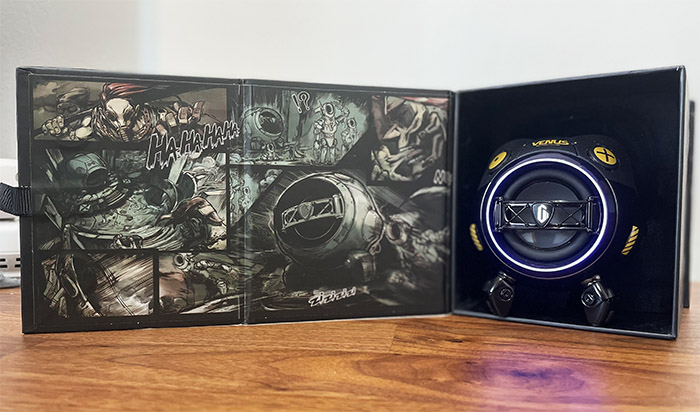
Internal Hardware and Connectivity
Unlike the 20W Mars Pro, the GravaStar Venus has a 10W power output which is not really that much. But the manufacturer did try to make up for it by using full-range drivers with subwoofer. And it kind of worked because the Venus manages to deliver a very similar performance to the Mars speaker.
Aside from that, the GravaStar Venus does support Bluetooth 5.0 and the coverage is about 30 feet with some walls in between the source and the speaker, but with the doors open. And be very aware that not all sources are the same: for example, while the speaker was connected to a PC, the sound was awful, but when connected to an iPhone, it sounded like a different device.
So, you may have to check the drivers and the codec support on your source machine. One annoyance that I encountered was that I couldn’t pair a Venus and a Mars speaker, they need to be from the same gen (G1 or G2). Also, it’s only possible to create a stereo system, so you can’t pair more than two GravaStar Venus speakers at the same time (no surround sound).
Sound Quality
I usually run some technical tests when checking out the TWS earbuds to see the driver quality, if they’re calibrated properly and if they’re matching. But I only had one GravaStar Venus, so the sound test will be done in mono mode.
But I still decided to play a tone that goes from low frequencies (20Hz) to higher frequencies (2kHz) to see if I can hear some rattle. And, while the speaker sat on my desk, everything went fine. But, I could hear some rattle between 40 and 270Hz when I put it on a uneven stand (that hand thing from Ikea).
I know most of you are aware of this, but for those that don’t, it’s incredibly important the location of your speaker, because the surface, the type of walls, the height, all these can make a difference in the sound quality. So, I kept the GravaStar Venus close to a wall and listened to some songs.
First, I checked “Zhu – Faded” which is a low-bass-focused song and the bass is definitely incisive, but not necessarily full. I mean, it’s possible to make it sound fuller, by bringing it a few inches closer to the wall. The voice was very clear with no noticeable bleeding and there were also no distortions at a higher volume (80%).
I then switched to ‘System Of A Down – Mr Jack’ and it’s a very busy song, but the the voices remained clear, a very bit forward. The drums and the guitars weren’t really that perfectly defined and the overall sound was a bit crowded.
After playing ‘Sail – Awolnation’ I immediately realized that it sounded unnatural because some instruments were clearly positioned (especially the bass), while everything else was pushed back. The voice would come forward and then go backwards like in a cycle. And I think this happens due to the construction of the speaker itself. The bass seems to be focused backwards, while the rest of the sound comes forwards, so a song such as Sail is just not the ideal for this type of setup.
Then, I checked ‘Morph The Cat by Donald Fagan’ for the mid-bass and there seems to be some light bleed into the mids, but overall, there was a good representation of the sound. Listening to ‘Sofi Tukker – Déjà Vu Affair’, I noticed that the beats sounded good, but the female voice was a bit forward. I then played ‘Vance – She Burns’ and it was a nice clear voice representation – while the female voice in other songs do come more forward, as seen before.
Afterwards, I wanted to check the treble and I played ‘Guns n Roses – Sweet Child o Mine’. The guitar sounds nice at the beginning, but the bass definitely overshadows it; the voice is decently reproduced and overall, the sound is not too bright, which is excellent. Then, listening to ‘Empire of the Sun – Alive’, I realized that there was no sibilance which is again, really great for a speaker.
The Latency
GravaStar mentioned that the Venus speaker will do great with games due to its low latency, so I put that claim to the test.
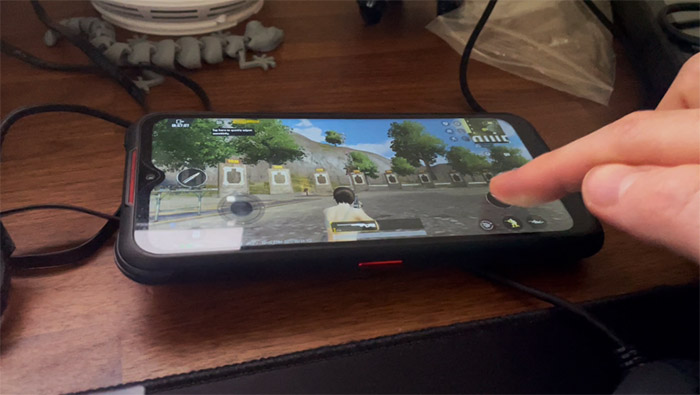
I filmed myself playing PUBG Mobile which is pretty much the go-to game for latency-related tests and I measured the amount of time it takes the phone to produce the sound without being connected to the speaker. And, since I filmed at roughly 30fps, every frame was about 0.034s; this way, I concluded that the reaction time was about 7ms, which is excellent.
After being connected to the GravaStar Venus, I saw that there was a latency of about 17ms, so it’s actually really good and indeed suitable for competitive gaming. It’s actually a bit better than the Gaming Mode on the GravaStar Sirius.
The Battery Life
The GravaStar Venus is equipped with a 1,500mAh which is way less than the 10,000mAh of the Mars speaker.
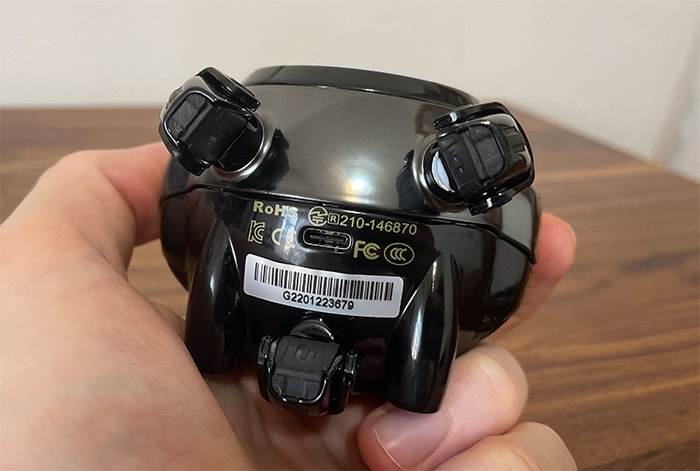
But even so, the manufacturer advertises that the Venus will be able to offer 10 hours of continuous music listening, which is quite the feat in terms of efficiency if it turns out to be accurate.
And the actual battery life is ridiculous since I struggled to get to go to zero. I kept the volume at 70% just because it would get so loud otherwise and it took 11 hours and 17 minutes to fully deplete the battery. I think that the advertised results were at 100% volume. I can’t be sure if it will stay like this for a long time, but at this moment, the battery life is very good.
The GravaStar Venus as a Bluetooth speaker
If I would listen to two GravaStar Venus in stereo mode, the songs would definitely sound better, but that’s not really the point of a Bluetooth speaker. It needs to be loud and clear, so is the Venus up to the task? It is. It produces a very mainstream sound, with a focus on the bass, slightly forward mids and clear treble, and most importantly, there are no distortions at a higher volume level.
And that’s what the majority of people actually need. The battery life is very good considering the size of the speaker and the build quality is excellent, so, if you’re in the market for a uniquely designed Bluetooth speaker, the GravaStar Venus is a solid option.

Mark is a graduate in Computer Science, having gathered valuable experience over the years working in IT as a programmer. Mark is also the main tech writer for MBReviews.com, covering not only his passion, the networking devices, but also other cool electronic gadgets that you may find useful for your every day life.

